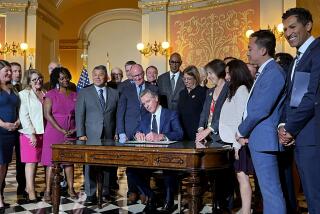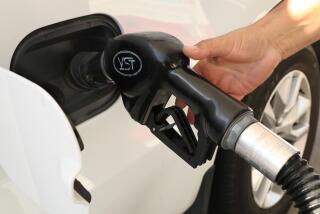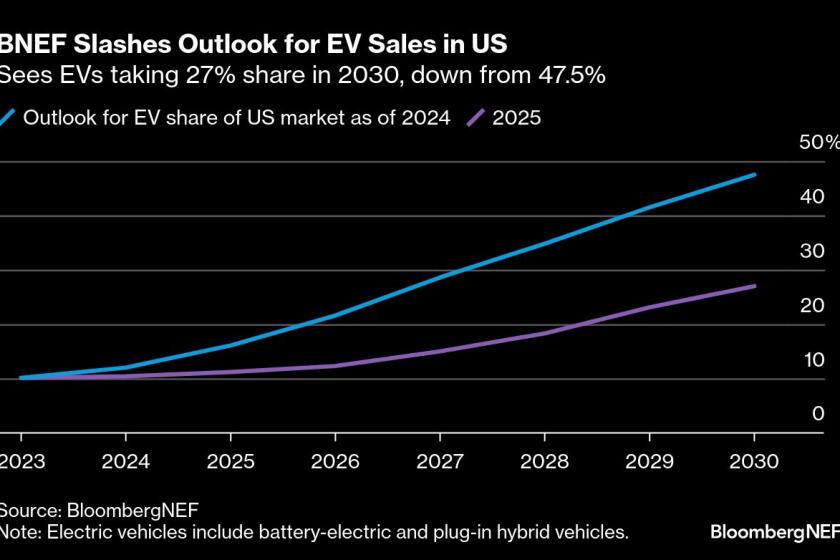A lot less fuming at the gas pump this time
- Share via
Gas prices have soared about 15% in the last six months, hitting $3.94 a gallon on average nationwide, and $4.29 in California.
The mood of motorists? Meh.
Partisan finger-pointing aside, polls suggest that most people aren’t as worked up over gas prices as they were four years ago, when a gallon of regular hit a national average of $4.11 a gallon. Nor has there been as much clamor for drastic measures, such as tapping the Strategic Petroleum Reserve in Texas and Louisiana.
“I think we all have adjusted,” said Lara Clayton of Los Alamitos as she spent nearly $60 recently to fill up her 2008 Lincoln Town Car at a Seal Beach 76 station. “We just don’t drive as much and we are careful to combine errands.”
That’s one reason for the comparative complacency, and economists and industry observers say there are others.
A big factor is that the current run-up in fuel prices has been nowhere near as steep as in 2008, when prices escalated 35% in six months.
Having already seen prices cross the $4 barrier, motorists are less likely to become outraged when they see it happen again, said Michael Sivak, who heads the University of Michigan’s Transportation Research Institute. And because the costs of other items have risen -- notably food -- it stands out less as a household budget buster.
“If we adjust for inflation, gas costing $4 a gallon now is analogous to gas costing $3.72 four years ago,” Sivak said.
Another factor is that more people are driving fuel-efficient cars, as older gas-guzzlers are gradually replaced with new vehicles that get better mileage.
Auto sales figures this week demonstrate that trend. Through the first three months of the year, sales of small cars accounted for 27% of retail car sales, said research firm J.D. Power & Associates. Toyota sold a record 29,000 of its Prius hybrids last month, making it the sixth-most popular vehicle in March. More than 40% of the vehicles General Motors sold last month had the smaller four-cylinder engines, a company record.
With more hybrids and four-cylinder engines in the mix, the vehicles sold in February 2012 get nearly 17% better mileage than those purchased in February 2008, Sivak said.
One reflection of that is evident in figures from the U.S. Energy Information Administration and the Federal Highway Administration. Americans drove just 1% fewer miles last year compared with 2010, but the nation used 3% less motor fuel.
That may help explain the results of a recent Washington Post poll. Asked whether “recent price increases in gasoline caused any financial hardship for you or others in your household,” 63% of the respondents said yes. That’s well below the 77% that answered yes during the price surge of 2008, and it was the lowest affirmative response to the same question in five years.
Still, Americans are feeling the pain, and if prices cross the $5-a-gallon line, there could be a lot more furor. Gallup polled drivers last month and found that about 14% said that even gas priced under $4 a gallon forced them to make lifestyle choices. And 28% said a price point in the $4 range caused them to reduce spending in other areas.
But the tipping point comes above $5, at which level 76% say they would start changing spending habits. With the national average for regular gasoline still under $4 a gallon, Gallup said its data suggest that “there is room for a considerably greater increase in gas prices before Americans say prices will begin to have widespread, serious consequences on their spending and lifestyle patterns.”
During previous surges, high gas prices ate into sales at fast-food restaurants and discount retailers such as Wal-Mart and Dollar General.
Back in 2005, when California gas prices were in the low-to-mid-$2 range, both consumers and politicians were more vociferous with their complaints, especially in California, where, because of refinery and fuel blend issues, prices are higher than in other regions. The House Oversight and Government Reform subcommittee on energy and resources even held hearings in Long Beach.
In 2006, the Federal Trade Commission launched an investigation to look at whether rising gas prices were the result of antitrust violations by oil companies or refiners. It eventually concluded that the increases were based on supply and market conditions.
That same year, the California Energy Commission launched its own investigation, eventually finding that unplanned refinery outages, unusually high fuel exports and tanker troubles -- not misdeeds by the oil industry -- were the primary drivers behind a springtime price surge.
As prices soared in 2007, state attorneys general jumped into the fray. Florida’s Bill McCollum said his office was looking at more than 200 complaints about price gouging at gas stations. That same year, the House approved a bill that made gasoline price gouging a federal offense.
This year, motorists are essentially saying, “We survived and moved on,” said Jeff Spring of the Automobile Club of Southern California, which closely follows fuel prices.
Activist Jamie Court, president of Consumer Watchdog in Santa Monica, calls it “capitulation.”
“After you get bonked on the head by $4 and $5 gasoline enough times, maybe it doesn’t hurt as much,” Court said.
Yet Court said he believes there’s still plenty of consumer angst bubbling under the outward signs of resignation, and that the public still views oil companies and their executives with disdain.
Long Beach City College education teacher Lee Douglas copes by filling his car every time the tank dips below half. The tab doesn’t feel as bad that way, Douglas said as he pumped $40 worth of gas into his Buick LaCrosse in Seal Beach.
“We have gotten to a point of acceptance,” he said, “whether we like it or not.”
--







